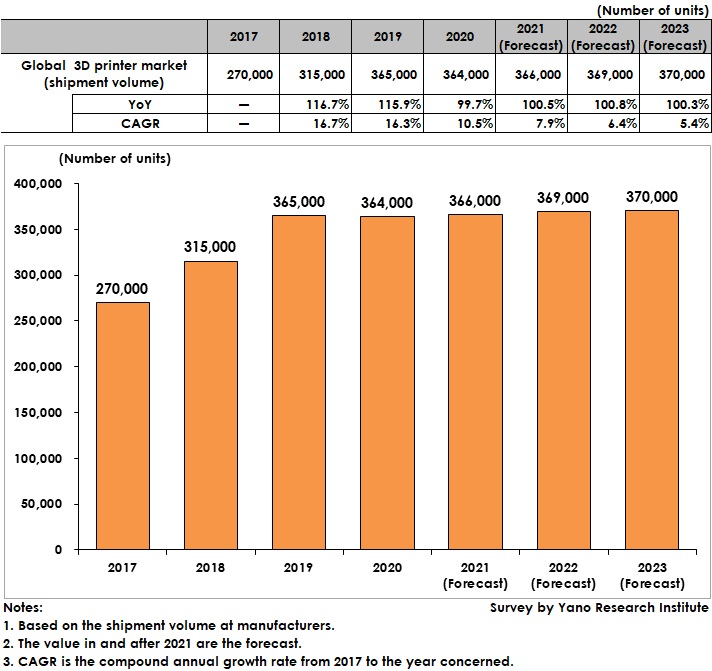No.2704
Global 3D Printer Market: Key Research Findings 2021
Global Shipment Volume of 3D Printers Projected to Increase to 370,000
Yano Research Institute (the President, Takashi Mizukoshi) carried out a survey on the global 3D printer market and found out the trends by demand category, trend of market players, and future perspectives.

Market Overview
The global three-dimensional (3D) printer market size in 2020, based on the shipment volume at manufacturers, declined to 364,000 units, 99.7% of the size of the previous year, affected by the COVID-19 pandemic.
2020 saw a fragmentation of supply chains and shortage of medical supplies, which drew the attention of 3D printers, driving the global 3D printing community to voluntarily provide masks and safety goggles free of charge. However, the shipment volume of 3D printers seemed to have failed to reach the estimation. While there were eager intentions around the world to mass manufacture end products, successfully accelerating the adoption of industrial 3D printers, some adoption plans were cancelled because of the costliness in the COVID-19 calamity, which slowed down the growth of shipment volume.
Investment to 3D printers, which has been said as aggressive IT investment carried out as an innovative attempt, is likely to go through predicament until 2023, because many user companies downturned their finance stemming from spread of COVID-19 infections.
Noteworthy Topics
Influence of COVID-19 Infections
COVID-19 infections in 2020 led the characteristics of 3D printers to be reappraised. Especially, a fragmentation of supply chains triggered many user companies to pay attention to the printers as a method of manufacturing products at a place physically closer to the users. Even amidst the COVID-19 pandemic, the trend of sharing data and of production at a site close to the users is likely to continue, from a perspective of reducing transportation cost and of availability to manufacture based on the local demand.
Also, the user companies that used to utilize 3D printers only for producing a substitute to cover the loss from shortage of parts have begun reappraising 3D printers as a method that contribute in developing and producing the end parts in a short period of time.
Future Outlook
3D printers have become more and more intended for practical applications and mass production of end products for the industries including aerospace, automobiles, medical, house appliances, and molds primarily in Europe and China. Especially in the automobile industry, the manufacturing demand using 3D printers is projected to increase, aiming at weight reduction, performance improvement, and better fuel efficiency.
As products and services with labor-saved after-treatment (including removals of support materials) have been on the rise in recent years, the environment for using 3D printers has improved and has driven mass production of 3D printers. From the technological point of view, the printing speed, which used to be the challenge for 3D printers, has been faster, as a result of various efforts by the manufacturers. 3D printers are expected to accelerate the growth of the global market if larger and/or diverse types of objects can be created and if the quality assurance of the objects created can be established.
CAGR of the global market size of 3D printers, based on the shipment volume at manufacturers from 2017 to 2023 is expected to be 5.4%, with the market size projected to attain 370,000 units by 2023.
Research Outline
2.Research Object: 3D printer manufacturers, distributors, and service providers related with 3D printers, etc.
3.Research Methogology: Face-to-face interviews by the expert researchers, surveys via telephone/email, and literature research
What are 3D Printers?
A 3D printer in this research refers to a device for creating three-dimensional (3D) objects by laminating layers of resin or metals based on 3D data. There are several techniques for rapid prototyping depending on the methods or materials to use: FDM (fused deposition modeling), light modeling, SLS (selective laser sintering), inkjet, and etc.
<Products and Services in the Market>
3D printer
Published Report
Contact Us
The copyright and all other rights pertaining to this report belong to Yano Research Institute.
Please contact our PR team when quoting the report contents for the purpose other than media coverage.
Depending on the purpose of using our report, we may ask you to present your sentences for confirmation beforehand.